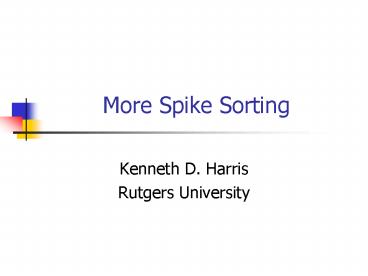More Spike Sorting - PowerPoint PPT Presentation
1 / 26
Title:
More Spike Sorting
Description:
... intra- and extra-cellular recordings allow us to estimate errors. ... Simultaneous recording with a wire tetrode and glass micropipette. Intra-extra Recording ... – PowerPoint PPT presentation
Number of Views:72
Avg rating:3.0/5.0
Title: More Spike Sorting
1
More Spike Sorting
- Kenneth D. Harris
- Rutgers University
2
How Do You Know It Works?
- We can split waveforms into clusters, but are we
sure they correspond to single cells? - Simultaneous intra- and extra-cellular recordings
allow us to estimate errors. - Quality measures allow us to guess errors even
without simultaneous intracellular recording.
3
Intra-extra Recording
- Simultaneous recording with a wire tetrode and
glass micropipette.
4
Intra-extra Recording
Extracellular waveform is almost minus derivative
of intracellular
5
Bizarre Extracellular Waveshapes
Model
Experiment
6
Waveshape Helps Separation
7
Two Types of Error
- Type I error (false positive)
- Incorrect inclusion of noise, or spikes of other
cells - Type II error (false negative)
- Omission of true spikes from cluster
- Which is worse? Depends on application
8
Manual Clustering Contest
9
Best Ellipsoid Error Rates
Find ellipsoid that minimizes weighted sum of
Type I and Type II errors. Must evaluate using
cross-validation!
10
Humans vs. B.E.E.R.
11
Why were human errors so high?
- To understand this, try to understand why
clusters have the shape they do - Simplest possibility spike waveform is constant,
cluster spread comes from background noise - Clusters should be multivariate normal
12
Problem Overlapping Spikes
13
Problem Cellular Synchrony
14
Problem Bursting
15
Problem Misalignment
- When you have a spike whose peak occurs at
different times on different channels, it can
align on either. - This causes the cluster to be split in two.
16
Problem Dimensionality
Manual clustering only uses 2 dimensions at a
time BEER measure can use all of them
17
Automatic Clustering
- Uses all dimensions at once
- Errors should be lower
- Still requires human input
18
Human-machine Interface
19
Semi-automatic Performance
20
Cluster Quality Measures
- Would like to automatically detect which cells
are well isolated. - BEER measure needs intracellular data, which we
dont have in general. - Will define two measures that only use
extracellular data.
21
Isolation Distance
Size of ellipsoid within which as many spikes
belong to our cluster as not
22
L_ratio
23
False Positives and Negatives
24
Which Measure to Use?
- Isolation distance correlates with false positive
error rates - Measures distance to other clusters
- L_ratio correlates with false negative error
rates - Measures number of spikes near cluster boundary
25
Conclusions
- Automatic clustering will save time and reduce
errors. - Errors can be as low as 5.
- Quality measures give you a feeling of how bad
your errors are.
26
Room for Improvement
Easy
- Make it faster
- Better human-machine interaction
- Improved spike detection and alignment
- Quality measures that estimate error
- Fully automatic sorting
- Resolve overlapping spikes
Hard































